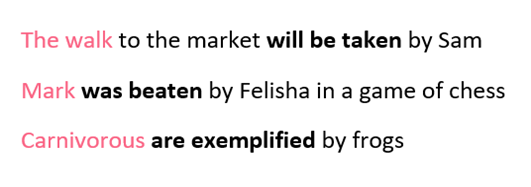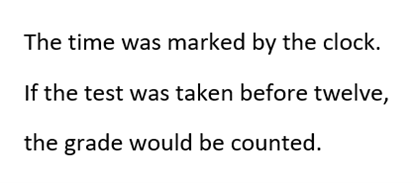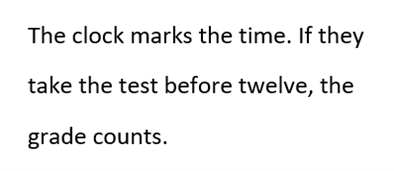What is an active and passive verb?
In order to understand active and passive verbs, let’s first define what a verb is. Take a look at the table below for the standard definition of a verb. 
|
Definition |
Examples |
| Verb |
Expresses an action or state that usually relates two things |
To run, to walk, to swim, to laugh, to have |
As you can see, verbs can sometimes make up the bulk of our dialogue. In the English language, verb conjugation is pretty simple in comparison to other languages. Compare the conjugation of the verb ‘to run’ in English versus french.
|
French |
English |
| I (je) |
cours |
run |
| You (tu) |
cours |
run |
| She/he (elle/il) |
court |
runs |
| We (nous) |
courons |
run |
| They (elles, ils) |
courent |
run |
When we talk about active and passive verbs, then, we’re not really talking too much about the conjugation of the verb. Instead, it is dependent on what the subject in the sentence is doing. Take a look at the definition of active verbs below.
|
Definition |
Subject |
| Active verb |
When the subject of the verb is performing the action |
Who or what the sentence is about (performing action verbs) |
Now that we’ve covered an active verbs definition, let’s take a look at some active verbs examples.  Let’s take a look at passive verbs definition:
Let’s take a look at passive verbs definition:
|
Definition |
Subject |
| Passive verb |
When the subject is being put through the verb action |
Who or what is receiving the action of the verb |
Let’s take a look at some examples of passive verbs. 
How do you know if a verb is active or passive?
One easy way to spot the difference between an active and passive verb is to understand whether the speaker is taking an active or passive tone. Now that you understand what is and active and passive verb, let’s take a look at the definitions of an active and passive voice below.
|
Definition |
Subject |
| Active voice |
Uses an active form of verbs |
Subject is performing an action |
| Passive voice |
Uses a passive form of verbs |
Subject is receiving the action from the verb |
As you can see, when a speaker is using passive verbs, they are employing a passive voice. Let’s take a look at an example of a passive voice.  Here, we can break down each section as an example to see why the voice is passive or active.
Here, we can break down each section as an example to see why the voice is passive or active.
|
Subject |
Passive verb |
| The time was marked by the clock |
The time |
Was marked |
| If the test was taken before twelve |
The test |
Was taken |
| The grade would be counted |
The grade |
Would be |
Let’s take a look at an example of an active voice.  Again, breaking down each section gives us more clarity on why this voice is an active one.
Again, breaking down each section gives us more clarity on why this voice is an active one.
|
Subject |
Active verb |
| The clock marks the time |
The clock |
marks |
| If they take the test before twelve |
They |
take |
| The grade counts |
The grade |
counts |
What is an active verb example?
Let’s break down an example of an active verb. Remember that an active verb is used when the subject of the sentence is performing the verb. Let’s take a look at some examples. Try your best to break down each example and decide whether or not they are using an active verb or passive verb.
|
Sentence |
Active Verb? |
| Example 1 |
Your grandma made the pierogies? |
? |
| Example 2 |
The tornado destroyed much of what was left. |
? |
| Example 3 |
I wanted to go, but I was busy. |
? |
Let’s take a look at the answers, as well as an explanation for why.
|
Sentence |
Active Verb? |
Subject |
Verb Performed by Subject |
| Example 1 |
Your grandma made the pierogies? |
Yes |
Grandma |
made |
| Example 2 |
The tornado destroyed much of what was left. |
Yes |
Tornado |
destroyed |
| Example 3 |
I wanted to go, but I was busy. |
Yes |
I |
wanted, was |
When you use active verbs, you are using an active voice. Active voices are usually used in essays and in day-to-day life. 
What is a passive verb example?
Now that we’ve looked at some examples of active verbs, let’s turn to look at passive verb examples. Recall that when we have a passive verb, the subject of the sentence is having the verb performed onto them. Looking at the examples below, try to identify which are passive verbs.
|
Sentence |
Active Verb? |
| Example 1 |
The pizza was burned by the oven. |
? |
| Example 2 |
Trains are driven by train conductors. |
? |
| Example 3 |
You were gone by evening. |
? |
Let’s take a look at the answers, as well as an explanation for why.
|
Sentence |
Active Verb? |
Subject |
Subject Receiving Verb’s Action |
Received from |
| Example 1 |
The pizza was burned by the oven. |
Yes |
Pizza |
Was burned |
Oven |
| Example 2 |
Trains are driven by train conductors. |
Yes |
Trains |
Are driven |
Train conductors |
| Example 3 |
You were gone by evening. |
No |
- |
- |
- |
When you use passive verbs, you are using a passive voice. Passive voices shouldn’t be used in essays. They are, however, often used in journalism. Listen to the news and you should find plenty of examples of sentences with passive verbs. 
Why are passive verbs used?
There are many different reasons why passive verbs are used. When you’re writing in any academic setting, active verbs are usually encouraged because they produce an active voice. However, there are some instances where you might want to use passive verbs. Take a look at some of the reasons why you might prefer to use passive verbs overactive verbs. Along with each reason, you will find an example.
| Reason |
Example |
How |
| Focus on subject who is receiving the action rather than who is doing the action |
Glass is made by melting down and chemically altering sand. |
We don’t focus here on who made the glass but how it is made. |
| Avoid stating irrelevant information. |
The car was designed to withstand lightning strikes. |
We don’t care who made the car but rather it’s features. |
| Avoid repeating information |
The impact of the study is discussed in the conclusion. |
The author is discussing it, so it is not worth repeating. |
| Taking on an academic/professional tone |
The sample was taken from a representative group. |
We don’t have to use personal pronouns (we, I, etc.) |



 Let’s take a look at passive verbs definition:
Let’s take a look at passive verbs definition: 
 Here, we can break down each section as an example to see why the voice is passive or active.
Here, we can break down each section as an example to see why the voice is passive or active.  Again, breaking down each section gives us more clarity on why this voice is an active one.
Again, breaking down each section gives us more clarity on why this voice is an active one. 
